Why do spots appear on the leaves of the apple tree and what to do?
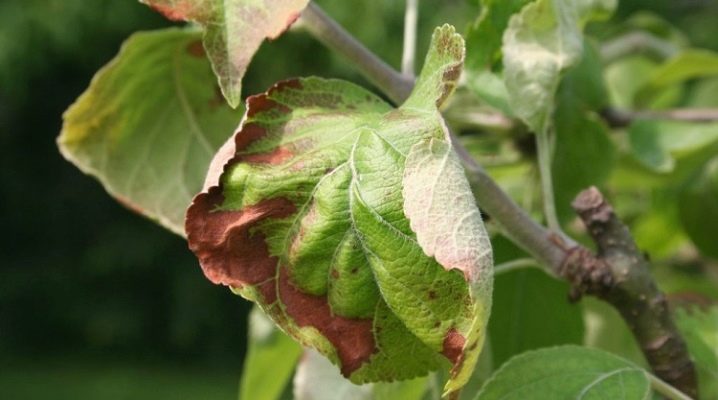
On apple leaves, you can often see spots of different shades. As a rule, they indicate that the tree is sick, and it needs to be treated urgently. Otherwise, there is a huge risk of being left without a crop. We will talk about what diseases can cause spotting, and how to treat them, in this article.
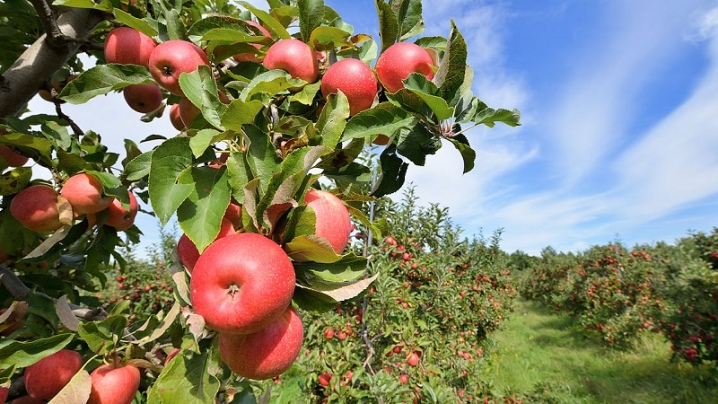
The main reasons for the appearance
Scab
This disease is considered one of the most dangerous for apple trees. It is of fungal origin and is very active against the tree. The disease spreads especially quickly at low temperatures and high levels of humidity. The fact that the tree is sick with scab is evidenced by the presence of small specks, dots and sores on the foliage. Over time, the spots begin to turn brown in the middle, and then crack, which can easily contaminate the plant with rot.
The more the disease progresses, the weaker the apple tree becomes: she begins to shed foliage and fruits, which are also covered with spots. If apples remain on the branch, then they lose their taste and visual appeal. It is possible to treat this disease with the help of biological products. However, you should not forget about treatment for preventive purposes, which will help prevent the onset of the disease.
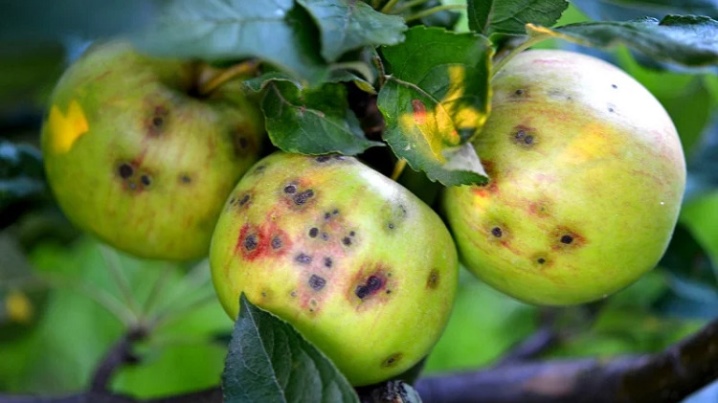
Rust
Another fungal disease, the presence of which is evidenced by numerous red, dark red, orange spots on the foliage, with black dots inside... Often the disease is transmitted to the tree from the juniper. At the same time, cracking of the bark initially occurs, brown growths and mucus are formed in the cracks, and after that the disease begins to precipitate the apple foliage.
You can treat this disease. To do this, you need to get rid of the affected areas of the tree, including foliage, branches or fruits. Please note that you should not leave those parts on which there are spots that are not large in size. After removing the affected parts, it is necessary to treat the wood with chemical agents.
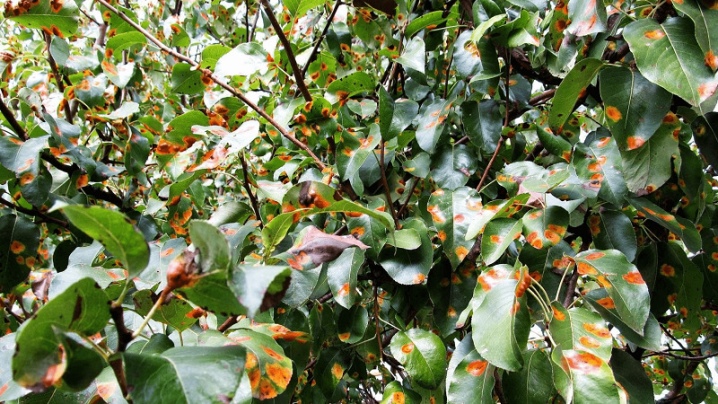
Powdery mildew
A disease that a tree infects through fungal spores. As a rule, it manifests itself in the last spring month. The presence of the disease during this period is evidenced by serous plaque, which forms on young foliage and inflorescences. The ovary does not form in the affected buds, and the diseased foliage begins to curl up and die off. If the disease appeared during the formation of apples, then a mesh of cork tissue appears on them.
To get rid of the disease, it is necessary to eliminate all affected areas and treat the cut sites with fungicidal agents.
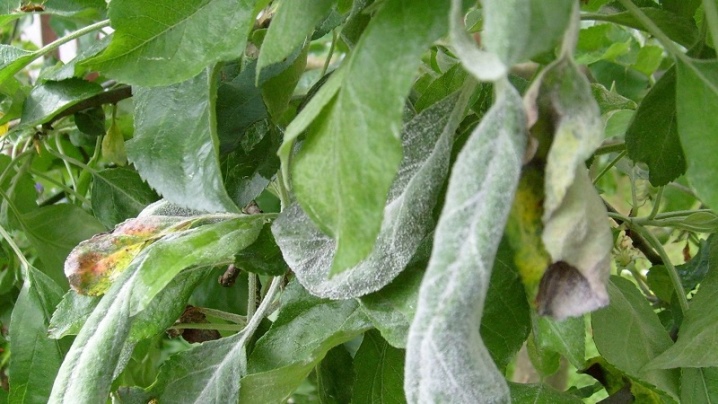
Brown spot
The second name for this fungal disease is marsoniasis. It appears most often on those trees whose roots are given too little attention. This disease actively affects the inflorescences, which is why the apple tree subsequently does not produce a large number of fruits. The presence of the disease in the plant is indicated by uneven spots of a yellowish tint. They can have a brown "rim", or they can do without it.
With the development of the disease, foliage and young shoots begin to turn yellow, dry and fall off, which prevents the development of the apple tree. To get rid of the disease, the tree must be sprayed with fungicidal preparations and antibiotics.
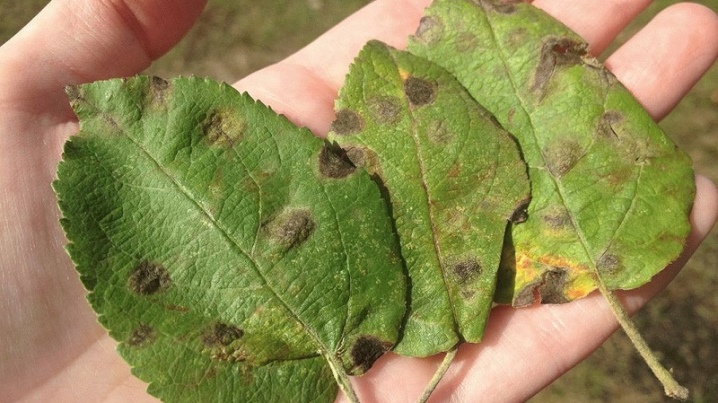
Bacterial burn
This disease becomes more active in the spring, when the branches and buds turn brown. With the development of the disease, young shoots begin to turn black and dry, black spots form on the foliage - tissue necrosis occurs. The diseased bark of the tree begins to swell, sores appear, the borders of which have a purple hue. A sour scent usually emanates from the affected areas. Further, the sores begin to dry, darken and fall off. Slime will be visible on the cut of the affected bark.
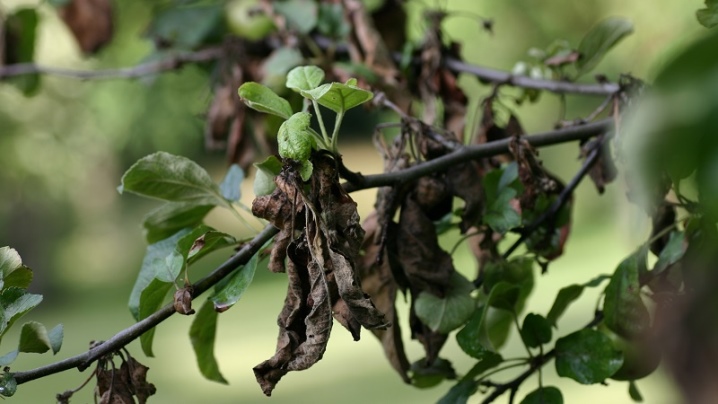
Fruit rot
The second name for this dangerous fungal disease is moniliosis. If a plant gets sick with this disease, then its fruit branches, flowers with ovaries and shoots get burned, after which they begin to dry. For a long time they continue to stick to the tree without falling. At the same time, the fruits of the apple tree can rot. Usually, this disease is spread by wind and spores and develops actively in cold and wet springs.
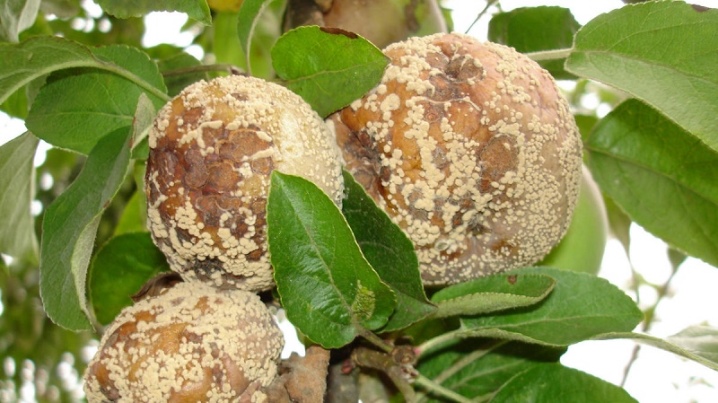
Chlorosis
Chlorosis is less common. With it, the process of chlorophyll formation in the leaves is disrupted, they acquire a pale green or yellowish tint. In addition, nutrients cease to flow normally to the shoots, which does not in the best way affect their development.
Most often, chlorosis occurs due to mechanical damage to the bark and the influence of frost in the winter. The diseased bark subsequently begins to die off or become covered with cracks, where harmful fungi can easily penetrate, causing root or stem rot.

Mechanical damage
Most often, it is mechanical damage that becomes the main cause of tree infection. Such damage can occur under a variety of circumstances: during a storm, harvesting fruits, during transportation.
In any case, the damage must be disinfected, otherwise the plant may suffer.

Treatment overview
If the tree is not treated, then there is a high risk of losing the crop, and the plant itself may die. This must be done urgently, having noticed the first symptoms, so as not to start the disease. To fight stains on the leaves of the apple tree, it is recommended to use the following products: "Phytomycin", "Raek" and Bordeaux liquid. It is they who have shown themselves best in practice.
- "Phytomycin" Is a biological agent that acts as an analogue of a natural antibiotic and acts half a day after the treatment. It does not spoil the microflora of the earth in which the apple tree grows, and does not have a negative effect on warm-blooded animals. It is especially recommended to use this drug for moniliosis or bacterial burns.
- "Rayok" - this is another remedy that can actively fight fungi, it is often recommended to use it for scab or powdery mildew. The drug is quickly absorbed, which happens within 2 hours after treatment, gives a long-lasting effect, while the rain is not afraid of it.
- Bordeaux liquid - It is one of the most popular remedies for disease control, be it scab, fruit rot or other spots. It is quite easy to use the drug: it just needs to be diluted with water. The advantage of this remedy is that it does not cause burns in the tree. They begin to use it in early spring and during the growing season.
Note that when processing wood with any of these tools, you must observe safety precautions: do not neglect respirator and protective clothing. Otherwise, there is a risk of harm to your health.

Prevention measures
Compliance with preventive measures helps to prevent the occurrence of diseases or get rid of them in time... So, after harvesting the fruits closer to autumn, all old leaves must be collected and burned. This is explained by the fact that harmful fungal spores can remain on such foliage. In addition, pests can also hide under it. Pay great attention to the choice of seedlings for planting: they must be smooth, without visible damage. Fight harmful insects. They are often the carriers of infectious diseases.In addition, pests often inhibit the development of a tree, feeding on its juices and other useful substances.
Disinfect your garden tools regularly... Otherwise, there is a risk of transferring the infection from the affected tree to a healthy one. At low temperatures, it is advisable to heat the apple tree. To do this, you can make bonfires next to the tree.
Don't forget about preventive tree treatments. This will help prevent disease from occurring.
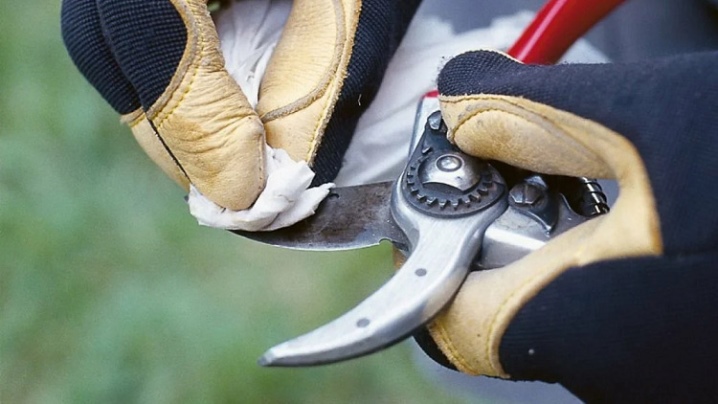













The comment was sent successfully.